|
The Pin-tailed Parrotfinch
(authors: Gerhard Hofmann, & Karl-Heinz Wörz)
Erythrura prasina (SPARRMANN, 1788)
Is there a common sense for beauty? A question which behavioral biologists and psychologist would like to answer since long. A bird can be as colorful as a Gouldian finch there will always be some breeders that are not appealed by it - everybody prefers another species. SO the everybodys darling species doesnt exist?
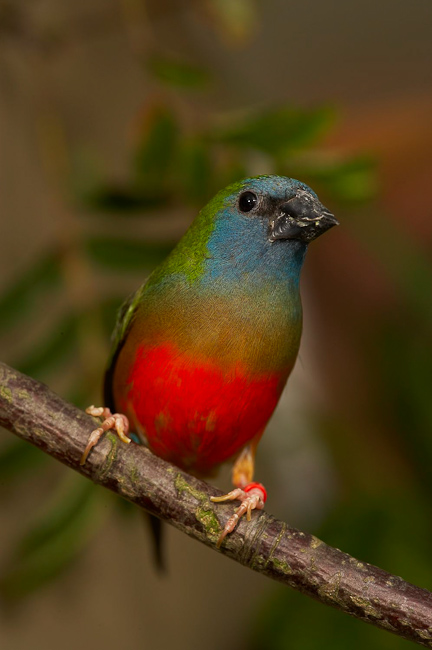 
Well there is one which is pretty close to it, which is popular among most bird-lovers; the Pin-tailed parrot finch. It is not only amazingly colorful but it is also a very active bird and unites most of what makes a most wanted bird among bird-breeders. Not too long ago, thousands of them were imported every year. They were readily available for few money, in fact there were so many birds available that it was difficult to sell birds bred in captivity. Well… times have changed dramatically. Now the Pintails get the attention they deserve, their price went up and most breeders of this lovely bird have a waiting list of people who would like to get one or two pairs. Despite the fact that nearly everybody agreed that this species is a fascinating beauty it never was as popular as other parrot finches. The reason is obvious; they were way cheaper and much more difficult to breed than the others. What made things even worse is that most birds arrived in Europe in bad health... in seriously bad health. It was not uncommon that most of the imported birds didnt survive their first year in captivity and only very few breeder managed to breed the species successfully. The knowledge of these early breeders is the foundation of the good breeding results some of us have today.
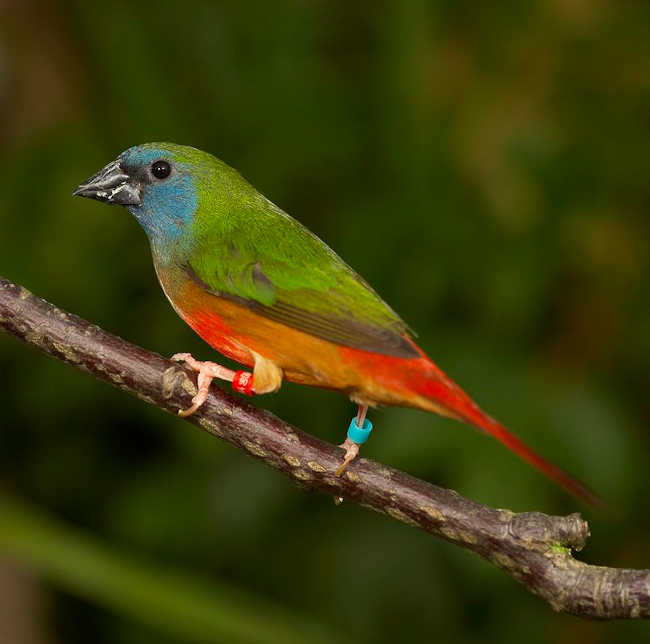 |
We are far from knowing everything about Pintails in captivity but there is even less known about the species in the wild. NICOLAI et al. (2001) mention that they avoid elevations higher than 1300m and the authors also mention the patchy distribution of the species. When they are spotted it is usually a small flock in a rice-field. Rice (milky, half-ripe!!) seems to be their main diet during most of the year but they also feed on grass- and bamboo-seeds and probably on other small seeds as well. They inhabit dense forest edges which are also the kind of habitat where most nests were found, mainly erected between epiphytic plants on trees or in dense bamboo. Surprisingly the nest can be found near the ground in the scrub-layer of the forest as well as 20m high in the canopy. The nest looks like a typical parrotfinch nest without an insulating layer of feathers in the center of the nest. In the wild, the clutch size ranges from four to six eggs. The breeding season in Java coincides with the rainy season in February and November.
The nominate form Erythrura p. prasina is known from Western Laos, Thailand, the Malay Peninsula as well as from Sumatra and Java, whereas the more colorful subspecies E.p.coelica is at home in Borneo. Sadly, in the last 20 years the latter one never made it to Europe. All birds which were supposed to belong to this subspecies turned out to be members of the nominate form. Among the imported birds were quite regularly yellow-bellied Pintails. This color morph does not constitute another subspecies but is a mutation which influences the synthesis of Carotinoides. These birds now longer produce the cantthaxantin responsible for the red color. The mutation can be found in males and females. The only difference between red- and yellow-bellied females is the color of the rump which is yellow with the mutants. Currently yellows are rarer than the red ones and as this mutation is inheriting recessive it will take a while until their numbers go up.
Well what is the forecast for the survival in captivity for this stunningly beautiful species? A couple of years ago I would not have given a cent for it but things have changed. Their high price and the effort of diligent breeders may very well be the key for a healthy captive population.
A huge advantage for a successful reproduction in captivity is that now nearly all birds in our aviaries are born in captivity which means the difficult phase of acclimatization is gone. No longer do we have to worry whether the birds will survive the first molt. As mentioned earlier most of the imports arrived in bad health often caused by the wrong food. Many exporters and importers kept them on dry hard paddy-rice only which led to vitamin deficiency as well as problems in the digestive tract. What made things worse was the fact that Pintails can be pretty stubborn and often refuse to eat anything else than this rice. Some breeders like MAYER (1994) had success with oats, whereas others like RANKE (1973) and KNÖCKEL (1979) offered germinated paddy-rice with great success. In countries which farm rice by far the best would be to offer milky half-ripe rice but sadly this is not available in the northern hemisphere. I am sure one could store it in the freezer like we do with half-ripe millet and wheat. now nearly all birds in our aviaries are born in captivity which means the difficult phase of acclimatization is gone. No longer do we have to worry whether the birds will survive the first molt. As mentioned earlier most of the imports arrived in bad health often caused by the wrong food. Many exporters and importers kept them on dry hard paddy-rice only which led to vitamin deficiency as well as problems in the digestive tract. What made things worse was the fact that Pintails can be pretty stubborn and often refuse to eat anything else than this rice. Some breeders like MAYER (1994) had success with oats, whereas others like RANKE (1973) and KNÖCKEL (1979) offered germinated paddy-rice with great success. In countries which farm rice by far the best would be to offer milky half-ripe rice but sadly this is not available in the northern hemisphere. I am sure one could store it in the freezer like we do with half-ripe millet and wheat.
SCHRÖPFER (1986) also mentioned the importance of easy to digest food and offered all kind of half-ripe grain like oat, wheat, ray-grass and spray-millet. Usually all the birds accepted canary-seed and spray-millet after a short period of hesitation. For imported birds it was also necessary to supplement their diet with vitamins in particular vitamin D and B (NICOLAI 1954). All authors agreed upon that it was difficult and mostly impossible to cure a bird that was seriously sick. Well this sad story is over; the birds available today are born in captivity and accept at least the food they have gotten at the breeder without problem. Therefore, it is certainly wise to copy the diet of the breeder at least for the first couple of weeks when you buy new birds.
It is possible to breed Pintails in cages but they should be as large as possible. The better way is to house them in structured aviaries as a small colony of three to four pairs. One or two additional females dont hurt and can be beneficial as they sometimes feed fledged youngsters from other pairs. Another very important factor for success is the temperature which should never fall below 25°C during breeding. There are some breeders like Karl-Heinz Wörz who have remarkable success with this species. When I was visiting him he had already 78 juveniles, all parent-reared, no fostering and the breeding season was not even over. Based on the experience of the early breeders he improved the diet and invented a special heated nesting platform. In Germany the little village Römerstein has become the capital-city of Pintails. possible to breed Pintails in cages but they should be as large as possible. The better way is to house them in structured aviaries as a small colony of three to four pairs. One or two additional females dont hurt and can be beneficial as they sometimes feed fledged youngsters from other pairs. Another very important factor for success is the temperature which should never fall below 25°C during breeding. There are some breeders like Karl-Heinz Wörz who have remarkable success with this species. When I was visiting him he had already 78 juveniles, all parent-reared, no fostering and the breeding season was not even over. Based on the experience of the early breeders he improved the diet and invented a special heated nesting platform. In Germany the little village Römerstein has become the capital-city of Pintails.
Lets now go into the details; what are the secrets to be so successful? One secret we mentioned already; K.H.Wörz is housing his birds always as a small flock in well structured spacious (2 x 0.8 x 2.3m length x width x height) aviaries. The need to keep several pairs together was already known before. KNÖCKEL (1979), SCHÖPFER (1986) and MAIJER (1988) emphasized the importance of this. The pintail is a highly social species and it stays social during the breeding season. Furthermore, such as my friend so had me and several other breeders of the pintails very good success with a flock consisting of two more females than males (e.g. 3.5 or 4.6). Often the real breeding pair plus one of the single females will feed the nestlings which is beneficial for the young as well as for the breeding pair which doesnt have to work so hard. WÖRZ never keeps his birds below 20°C and the humidity is around 60-65%. Daylight is from 5:30 AM until 9 PM. During the breeding season the flocks are usually housed as a single species flock. Occasionally some Munia or Painted Firetails are housed together with them. Pintails are very calm and peaceful birds. They are never engaged in serious fighting neither with their own mates nor with members of other species. As Pintails rarely accept novel food it is advanta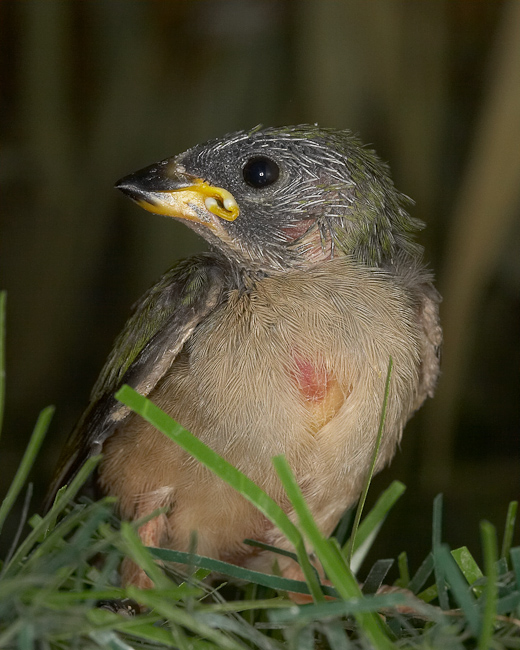 ges to house them together with species which have a broader food-spectrum like Red-headed parrotfinches which will act as tutor. This gets tricky during the breeding season. Pintails nearly never get fat even when they get very rich food as it is necessary during the breeding season. Unfortunately, this is not true for most other species which will gain a lot of weight with the same diet often more than is healthy for them. So birds housed together with pintails in a breeding aviary have to be closely observed and sometimes there is no other way than to remove them. ges to house them together with species which have a broader food-spectrum like Red-headed parrotfinches which will act as tutor. This gets tricky during the breeding season. Pintails nearly never get fat even when they get very rich food as it is necessary during the breeding season. Unfortunately, this is not true for most other species which will gain a lot of weight with the same diet often more than is healthy for them. So birds housed together with pintails in a breeding aviary have to be closely observed and sometimes there is no other way than to remove them.
The diet is another milestone for successful breeding - lets have a closer look. My friend and I relay on the German food supplier BLATTNER which has an excellent mixture for parrotfinches (containing a percentage of different grass seed instead only millet) - this is the basic nutrition for our birds. They also get another mixture consisting to equal parts of Japanese and white millet as well as canary seeds. Germinated Paddy-rice and oats are offered all year round, they also get fresh greens like lettuce and chicken-weed. Muli-vitamins (Nekton S) are offered once a week in the drinking water. Grit and sterilized cracked eggshells are available for the birds all year round. During the breeding season, this mixture is offered germinated. We offer 300 gr. germinated seeds mixed with 200ml peat (turf), 1 tea spoon dry inactivated brewers-yeast, ½ tea-spoon Nekton MSA (Calcium & vitamin D3) as well as 3 spoon of herbal-mixture (equal parts of chervil, thyme, sage, oregano, marjoram) and finally ½ tea-spoon of medical clay.
To get the bird in breeding condition we increase the temperature to 24-25° C and offer half-ripe white millet and wheat (half-ripe rice would be even better). Furthermore, beside the half-ripe millet we offer high amounts of milky wheat, milky rice would be on our list as well but is not available here. Additionally, the bird get the germinated seed mixture as well as frozen live food consisting mainly of buffalos and Pinkies and when available ant-puppaes. Our birds like our mixture of commercial egg-food (CEDE) with Nekton-Toni K - it guarantees that the birds get a sufficient amount of proteins while rearing their young.
Pint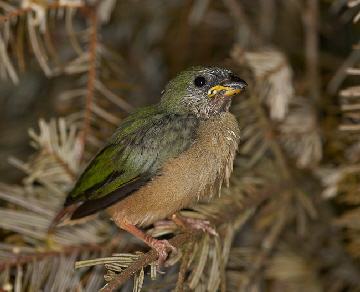 ails also like green grass-seeds like meadow- and ray grass and it is really no problem to get them to accept greens and half-ripe seeds. It is a different story with live-food or eggfood. For the pintails the shape of the food seems to be very important; the more similar it is to rice the more likely they will accept it. This probably is the reason why the birds dont feed on living mealworms but prefer frosted pinkies or ant-puppaes. WÖRZ had the idea to mix egg- food and live-food with the germinated seeds and use a protein supplement as well. The peat helps that this mixture stays fresh for a longer time, but nonetheless it has to be replaced daily better twice a day. ails also like green grass-seeds like meadow- and ray grass and it is really no problem to get them to accept greens and half-ripe seeds. It is a different story with live-food or eggfood. For the pintails the shape of the food seems to be very important; the more similar it is to rice the more likely they will accept it. This probably is the reason why the birds dont feed on living mealworms but prefer frosted pinkies or ant-puppaes. WÖRZ had the idea to mix egg- food and live-food with the germinated seeds and use a protein supplement as well. The peat helps that this mixture stays fresh for a longer time, but nonetheless it has to be replaced daily better twice a day.
We experienced with our own birds how important the animal-protein is for raising the young. When we bred our first Pintails without adding protein powder (Nekton Tonic K in our case) and the birds didnt accept the offered live-food the young never reached the same size as the adults. However, when we fostered four young with red-headed parrotfinches they reached exactly the same size as their genetic parents - a clear sign that the food fed by the Red-headed was more adequate than the one offered by the own parents. The only difference was that the Red-headed Parrotfinches were feeding egg-food and live-food to the chicks. Other breeders were complaining about the same, or had a lot of problems to breed them in the second generation as many birds were not fertile - again a sign for mal-nutrition. Thanks god nowadays these problems are history.
Beside the nutrition housing is one of the other key factors for success. As mentioned already Pintails are not very happy when they are housed in cages. The best is to keep a small flock in a well planted or structured aviary. Pintails inhabit rice fields, reeds and forest-edges and as all the birds living in this kind of habitat their claws grow fast. 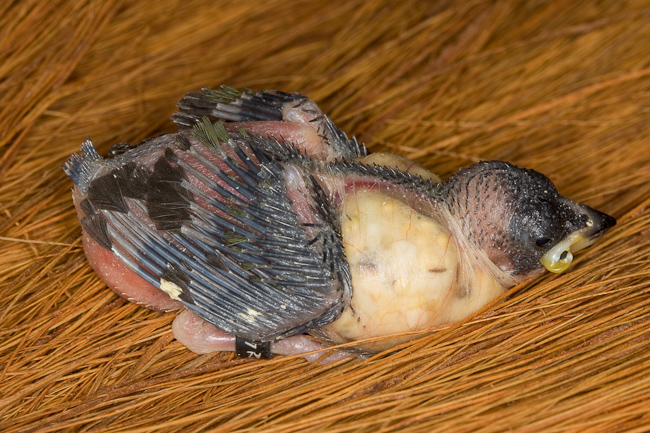 It is therefore necessary to check and cut the claws at least twice a year otherwise accidents will be unavoidable. Too long claws are sometimes the reason that the male doesnt fertilize the eggs. He simply cannot get hold on the female. Long claws are also often the reason why newly hatched nestlings are found out of the nest; they get entangled in the long claws and get carried out by accident. Even in well planted aviaries it is usually necessary to cut the claws once a year. We definitely would do before the start of the breeding season. It is therefore necessary to check and cut the claws at least twice a year otherwise accidents will be unavoidable. Too long claws are sometimes the reason that the male doesnt fertilize the eggs. He simply cannot get hold on the female. Long claws are also often the reason why newly hatched nestlings are found out of the nest; they get entangled in the long claws and get carried out by accident. Even in well planted aviaries it is usually necessary to cut the claws once a year. We definitely would do before the start of the breeding season.
Pintails love to take a bath and should have access to it all time - it helps to keep their feathers in good shape. As a tropical rain forest inhabitant the species never experiences really cold temperatures in the wild. We can do them a favor by never let the temperature drop much below 20°C. During the breeding season when chicks are hatched they need it even warmer; now the temperature shouldnt drop below 25°C. The same is true for the time when the young fledge.
The species was bred remarkably early already in 1880 by BARGHEER in England but there were not many success-stories until recently. Mostly the young died when the parents stopped brooding or the nutrition was simply not suitable for the species and the fledglings died as soon as they started to molt. Often the birds showed courtship behavior but didnt start to build a nest. Finally, for a long time there was the rumor that it is difficult to get male and female into breeding condition at the same time.
Well in contrast to most of the older literature it is not difficult to synchronize the sexes of the Pintailed parrotfinches. Pintails usually react with a complete molt to any dramatic changes such  as a change in temperature, diet or housing. So, we only have to change the diet from lean to rich and we will get the result what we want - both sexes molt at the same time. In the view of this it is no longer sure whether Pintails really molt twice a year. It may depend more on environmental factors. as a change in temperature, diet or housing. So, we only have to change the diet from lean to rich and we will get the result what we want - both sexes molt at the same time. In the view of this it is no longer sure whether Pintails really molt twice a year. It may depend more on environmental factors.
Pintails not only differ in their gestalt from other parrotfinches they also show a rather different behavior than other parrot finches. In contrast to most of their relatives they still show courtship display with nesting material but as most parrotfinches they copulate in the nest.
The birds like to erect their nest in dense scrub, but also accept common nestboxes. Our birds liked the nest-platform (see picture 1) which was developed by WÖRZ. In any case the birds prefer nesting sites which offer enough cover but they dont really prefer a specific height which reflects the behavior of the birds in the wild (see above). The nest has a massive wall with a relatively small entrance. As nesting material Pintails use coconut fibres, small leaves, or long soft grass; they are really not picky in their choice of the nesting material. Pintails dont line the nest-chamber with differently colored material but use softer material for the inner layers. Starting from scratch they can build their nest in just two days and as usual the male carries the material to the nest, whereas the female is responsible for the building of the nest.
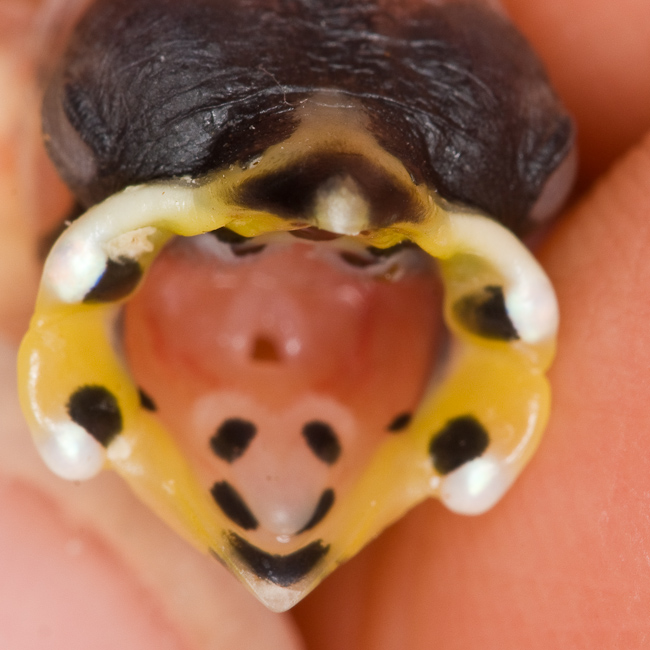 |
Pintails dont roost in nests. Males always sleep outside the nest and females only stay in the nest during incubation and approximately an additional 7 days for brooding the young. But both sexes brood and incubate by day. The short brooding period is responsible for a considerable amount of failed breeding attempts. When the temperature in the nest drops below 24/25°C the young will be dead the next morning. The naked chicks are not able to maintain their body temperature nor are they able to digest the food in the crop with low temperatures. The next morning the breeder will find well fed nestlings with the crop still filled with food but they will be all dead. The only solution is to heat the room up to around 25°C (measured near the nest as there can be a tremendous difference in temperature at various places in a room) or to use nest-boxes or platforms with heating devices. Suitable is what is safe and what the birds accept. 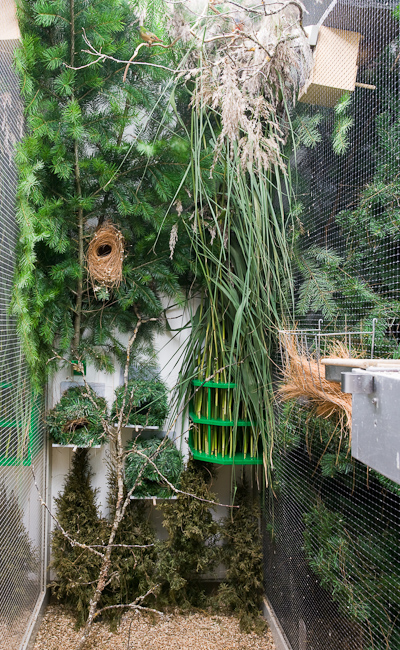 We had good results with heating-pads for orchids. WÖRZ uses heating-pads of the German electronic supplier Conrad-Electronic (just google for it) but he is an expert in this field and in any case I recommend consulting somebody who is an expert in this field … in case it is not built properly dry grass and coconut fibres are the perfect substrate to start a fire. We had good results with heating-pads for orchids. WÖRZ uses heating-pads of the German electronic supplier Conrad-Electronic (just google for it) but he is an expert in this field and in any case I recommend consulting somebody who is an expert in this field … in case it is not built properly dry grass and coconut fibres are the perfect substrate to start a fire.
In the old literature is mentioned that Pintails lay only 2-4 eggs but this no longer the case; with the change in diet came the larger clutch size and our birds lay between4-6 eggs as do the birds from WÖRZ. The incubation time is 14-16 days the same as for most of their relatives. Usually they incubate extremely reliable and dont care about the breeder controlling the nest. Nonetheless I would restrict controls to a minimum in particular with birds breeding for the first time. The newly hatched, light pink colored nestlings are totally naked which is common among Estrildians that live in areas with high night temperatures. To rear the chick is the duty of both parents but mostly the female is a little more diligent in feeding the young. Our birds feed mainly half-ripe wheat and germinated paddy-rice (again half-ripe rice would be the better!), the mixture of germinated seeds mentioned earlier. After hatching we mix it with Soy-powder and baby-food . Another source of protein, probably the most important one for our Pintails is Nekton Tonic K which we provide separately or mix with the germinated seeds, eggfood or softfood (Delikat Honig Supplier Blattner).
Usually the juveniles fledge with 18-19 days which is an indication that the nutrition is correct. If the parents dont get enough protein or if the temperature is too low they will fledge with 21-24 days.
It is very obvious how different the content of the crop looks in comparison to other finches. The crop is soft and there are only very few seeds to spot. This is in contrast to most other seedeaters like Gouldians or other parrot finches where the whole crop content persists of easy to identify food items. But this is in concordance to Pintails in the wild. Easy to digest food like half-ripe wheat and rice (or germinated paddy rice for the folks in the north) beside the temperature seems to be one of the key-factors for success, SCHÖFER mentioned this already 1986.
The first one or two days after fledging the juveniles often climb in the twigs and rest cuddling together. With 20 days they are fully airborne and nearly as agile and fast as their parents. The species-specific individual distance will show up one or two weeks later. Most of the parrot finches are surprisingly tame after fledging but if we think carefully it makes sense. They are very well camouflaged and in case they spot predators it is very likely safer for them to stay where they are and trust in camouflage than try to escape with limited flight- and orientation skills.
In contrast to most members of the family Estrildidae Pintails beg like real finches (Carduelis) stretch their neck and beg while flapping both wings. Around one week after fledging the youngsters start to feed on their own and after around one more week they dont receive food from their parents any longer. When the birds are housed in an aviary it is recommended to leave the youngsters in the aviary until they finish molt into the adult plumage. There is rarely any trouble with the parents and usually they dont disturb their parents which often are incubating the next clutch already when their first kids get independent. Molt into the adult plumage begins around six weeks of age and is finished around three months of age. The juveniles then look like adults although they still increase in body size and mass over the next couple of months. There is help for the noisy breeders which would like to know what sex the offspring is. WÖRZ detected that the juvenile males show already signs of the pintail when they fledge (see picture).
Juvenile Pintails start to sing very early, nearly at the same time when they start feeding on their own. When the birds are housed in a flock we often observed singing with listeners which is known from Gouldians and manikins. Several males gather around the singer and move closer and closer to listen to the song.
For the future of this species in captivity there were some seriously dark clouds on the horizon but thanks to breeders like Karl-Heinz WÖRZ who has managed to breed between 80 and 112 juveniles every year since 2007 we are pretty confident … yes the Pintail will make it.
I am sure the reader will agree with me that it is one of the highlights for a bird-breeder to see these colorful avian-jewels surrounded by the newly fledged offspring … I hope many more people will have the pleasure to experience it.
Literature:
HOFMANN, G. (1993): Prachtfinkenzucht: Lauchgrüne Papageiamadine. Voliere 16: 8-13
HILLER; E. (1998) Lauchgrüne Papageiamadine AZ-Nachr.
KARL, F. (1964): Lauchgrüne Papageiamadinen. Gef. Welt 88: 2-4
KNÖCKEL, H.(1981): Probleme bei der Haltung der Manila-Papageiamadine und der Zucht der Lauchgrüne Papageiamadine. Gef. Welt 105: 84
KNÖCKEL, H. (1981): Ergänzende Bemerkungen zur Haltung und Zucht der Lauchgrünen Papageiamadine. Gef. Welt 105: 92-93
KRAUS, K. (1965): Ein Beitrag zur Haltung der Lauchgrünen Papageiamadine. Gef. Welt 89: 88-89
LIMBERG, H. & K.T. SCHILD (1957): Zur Eingewöhnung von Lauchgrünen Papageiamadinen. Gef. Welt 81: 73-74
MAIJERR, P. (1988): Zuchterfahrungen mit Lauchgrünen Papageiamadinen. AZ-Nachr. 35: 128-130
MAIJERR, P.(1990): Zuchterfolge bei Lauchgrünen Papageiamadinen über mehrere Generationen. AZ-Nachr. 37: 321-325
MAYER, H. (1995): Erfahrungen mit der Lauchgrünen Papageiamadinen. Voliere 18: 274-277
NICOLAI, J.; STEINBACHER; J.; van den ELZEN, R., HOFMANN, G. (2001): Prachtfinken Australien, Ozeanien, Südostasien. Ulmer Verlag. Stuttgart
ROBILLER,F. (1978): Prachtfinken -Vögel von drei Kontinenten, 1.Aufl. VEB Deutscher Landwirtschaftsverlag, Berlin
RUß, K. (1898): Die Prachtfinken. 2. Aufl., Creutzsche Verlagshandlung, Magdeburg.
SCHRÖPFER, P. (1986): Fünf Jahre Erfahrungen mit der Lauchgrünen Papageiamadine. Monatsschrift SZG 31: 167-170
SIROKI, Z. (1979): Erfolgreiche Zucht der Lauchgrünen Papageiamadine. Gef. Welt 103: 181-182
SMYTHIES, B. E. (1981): The Birds of Borneo. 3. Auflage, Kuala Lumpur.
ULLRICH, M: (1995): Über Freileben, Haltung und Zucht der Lauchgrünen Papageiamadinen. Gef. Welt 119: 154-156
VOIGT, A. (1929): Unsere Vögel in der Sommerfrische. Gef. Welt 58: 7-18
WÖHRMANN, H.-J. (1995): Papageiamadinen. Eigenverlag
ZEUGE, G. (1975): Gelungene Zucht von Lauchgrünen Papageiamadinen (Erythrura prasina). Monatsschrift SZG 22: 177-181
ZISWILER, V., H. R. GÜTTINGER & H. BREGULLA (1972): Monographie der Gattung Erythrura Swainson, 1837 (Aves, Passeres, Estrildidae). Bonn. zool. Monogr. 2. Bonn.
|